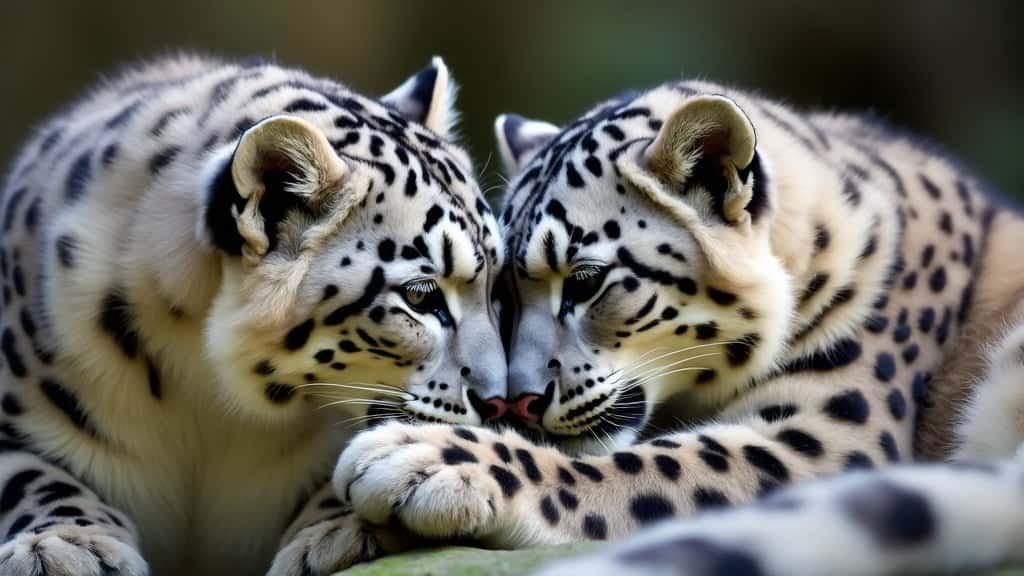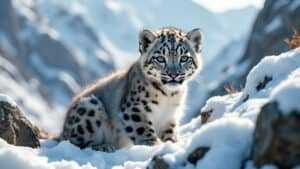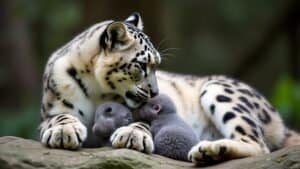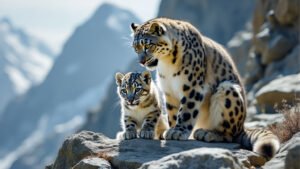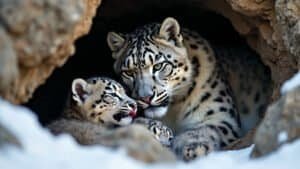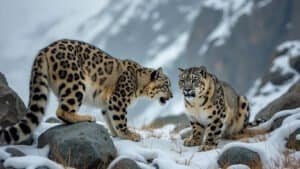Introduction
Snow leopards, the elusive big cats of the high mountains, have a unique and fascinating mating season. This article delves into the timing and duration of their mating season, the environmental factors that influence their reproductive behaviors, and the intricate courtship rituals they perform
We’ll also explore how snow leopards find mates in the wild, compare their mating habits to other big cats, and examine the impact of climate change on their reproductive patterns. Additionally, we will look at how conservation efforts are helping to support snow leopard mating and reproduction
The Mating Season of Snow Leopards
Snow leopards, known for their elusive nature and majestic appearance, have a specific mating season that is crucial for their reproduction and survival. This period is influenced by various environmental factors and is marked by unique courtship behaviors that ensure the continuation of the species
Timing and Duration
The typical mating season for snow leopards occurs during the late winter months, primarily between January and March. This timing coincides with the period when the weather is harshest, which may seem counterintuitive but has evolutionary advantages
The cold weather and snow cover ensure that the cubs, born after a gestation period of about 90-100 days, will arrive in the relatively more favorable conditions of late spring and early summer. This allows the mother to take advantage of the abundance of prey available during these months, increasing the cubs’ chances of survival
Environmental Influences
Environmental factors play a significant role in the timing and success of the snow leopard mating season. The snow leopards inhabit high-altitude regions of Central and South Asia, where the climate and geography can be extreme
The availability of prey, snow cover, and temperature are critical elements that influence mating behaviors. Adequate snow cover, for instance, is essential for providing the necessary camouflage for snow leopards, helping them hunt more effectively and maintain their energy levels during the strenuous mating period
Courtship Behaviors
Courtship among snow leopards involves a series of behaviors designed to establish pair bonds and ensure successful mating. Males and females communicate through vocalizations, scent marking, and physical displays
Vocalizations, such as yowls and chuffing sounds, are used to signal readiness and attract mates. Scent marking, done by both genders, involves rubbing their cheeks, flanks, and tails against rocks and vegetation to leave scent trails
Physical displays of affection, such as rubbing against each other, licking, and playful wrestling, are also common during the courtship period. These behaviors not only strengthen the bond between the mating pair but also serve to synchronize their reproductive cycles. The actual mating process is brief but can occur multiple times over several days to ensure fertilization
Snow leopards are solitary animals outside of the mating season, so the establishment of temporary pair bonds is critical for successful reproduction. Once the mating season is over, the male and female typically go their separate ways, with the female taking on the sole responsibility of raising the cubs
Finding Mates in the Wild
Snow leopards, typically solitary creatures, face unique challenges when it comes to finding mates in their expansive and rugged habitats
This section delves into the methods snow leopards use to locate potential mates, the role of communication and territorial behavior, and the challenges they face during this critical period
Communication and Signals
Snow leopards rely heavily on a combination of vocalizations, scent marking, and physical cues to communicate their presence and readiness to mate
Vocalizations include a variety of sounds such as growls, yowls, and purrs that can travel long distances across the mountainous terrain. These sounds serve to attract potential mates and signal reproductive availability
Scent marking is another vital form of communication. Both males and females use their urine and feces to mark territory boundaries and indicate their readiness to mate. They also use scent glands located on their cheeks, flanks, and tails to rub against rocks, trees, and the ground, leaving a chemical signature that can be detected by other snow leopards
This scent marking provides information about the individual’s reproductive status, health, and identity
Territory and Range
The territory and range of snow leopards play a crucial role in their mating strategies
Snow leopards are territorial animals, with each individual maintaining a large home range that can cover several square miles. The size and overlap of these territories vary depending on the availability of prey and the density of the snow leopard population in the area
During the mating season, males will often roam more extensively in search of receptive females. They follow scent trails and vocalizations to locate potential mates within or near their territory. The overlap of male and female territories increases the chances of encounters, facilitating the mating process
However, the vast and rugged nature of their habitat can make finding a mate a challenging endeavor, requiring significant energy and effort
Challenges in Mate Finding
Snow leopards face several challenges in finding mates, primarily due to their solitary nature and the expansive, difficult terrain they inhabit
One significant challenge is the low population density, which means individuals are often spread out over large areas. This low density reduces the frequency of encounters between males and females, making successful mating less likely
Human activities such as habitat fragmentation and poaching further exacerbate these challenges. Habitat fragmentation reduces the available territory for snow leopards, leading to increased competition for resources and territories. Poaching and human-wildlife conflict also threaten snow leopard populations, reducing their numbers and making mate finding even more difficult
Additionally, climate change impacts the snow leopard’s habitat and prey availability, altering traditional mating and hunting grounds. Changes in snowfall patterns, temperature, and vegetation can disrupt the delicate balance of the ecosystem, affecting the timing and success of the mating season
Despite these challenges, snow leopards have evolved to navigate their harsh environment and find mates successfully. Their communication methods, territorial behaviors, and adaptations to the rugged terrain all contribute to their reproductive success
However, ongoing conservation efforts are essential to address the threats they face and ensure the survival of these magnificent animals
Comparison to Other Big Cats
Snow leopards share some mating behaviors with other big cats, but they also exhibit unique traits adapted to their high-altitude environments. This section compares the mating habits of snow leopards to those of other big cats, highlighting both similarities and differences
Similarities in Mating Habits
Like many other big cats, snow leopards have a distinct mating season. This seasonality ensures that offspring are born at a time when environmental conditions are favorable for their survival
For example, lions, tigers, and leopards also have specific mating periods, although these can vary based on geographic location and environmental factors
Courtship behaviors, such as vocalizations, scent marking, and physical interactions, are common across big cat species. These behaviors facilitate communication and ensure that both partners are ready for mating
In snow leopards, as well as in species like tigers and leopards, scent marking is a critical way to convey reproductive status and territory boundaries. Vocalizations, although unique to each species, serve the same purpose of attracting mates and signaling readiness
The actual mating process is brief and can occur multiple times over a few days, a trait shared by most big cats. This repetition increases the chances of successful fertilization. After mating, the male typically does not stay with the female, leaving her to raise the cubs alone
This behavior is consistent among many big cat species, including snow leopards, lions, and leopards
Differences and Unique Traits
Despite these similarities, snow leopards exhibit several unique traits adapted to their mountainous habitat
One notable difference is their solitary nature and the vast territories they inhabit. While many big cats are solitary, the extent of snow leopards’ home ranges is significantly larger due to the sparse distribution of prey in their high-altitude environments. This extensive range can make finding a mate more challenging compared to big cats in more densely populated areas
Another unique aspect of snow leopard mating behavior is their silent nature. Unlike lions, which are known for their loud roars that can be heard for miles, snow leopards are relatively quiet. Their vocalizations, while effective in attracting mates, are not as loud or far-reaching as those of some other big cats
This adaptation likely helps them remain inconspicuous in their rugged terrain, where stealth is crucial for both hunting and avoiding detection by potential threats
The timing of the snow leopard mating season is also adapted to their environment. Mating during the harsh winter months ensures that cubs are born in late spring or early summer when conditions are more favorable. This timing contrasts with some other big cats, like the African lion, which can mate and give birth year-round, depending on the availability of resources
Snow leopards also face unique environmental challenges that influence their mating behaviors
The high-altitude, cold climates they inhabit require specific adaptations for survival, such as a thick fur coat and a powerful build for navigating rocky terrain. These adaptations also affect their reproductive strategies, making the timing and success of mating closely tied to environmental conditions
Impact of Climate Change
Climate change poses significant threats to snow leopards, impacting their mating season and overall reproductive success. This section explores how changing environmental conditions affect snow leopard mating patterns, the implications for their population, and their adaptation strategies
Changes in Mating Patterns
Climate change alters the high-altitude environments that snow leopards call home, disrupting traditional mating patterns. One of the primary ways this occurs is through changes in snowfall and temperature
Snow leopards rely on specific snow conditions to hunt effectively and move through their terrain. Reduced snowfall or changes in snow density can make it harder for them to hunt prey, affecting their overall health and readiness for mating
Warmer temperatures can also shift the timing of the mating season. Snow leopards typically mate in late winter, but as winters become shorter and less severe, the mating season could start earlier or become more erratic
This misalignment can lead to cubs being born at times when conditions are not ideal, reducing their chances of survival. Additionally, changes in vegetation and prey availability due to climate shifts can further complicate the timing and success of mating
Effects on Population
The impacts of climate change on snow leopard mating patterns have broader implications for their population dynamics. Disruptions in the timing and success of mating can lead to fewer cubs being born and surviving to adulthood. Over time, this can result in a decline in snow leopard populations, making them more vulnerable to extinction
Habitat loss due to climate change exacerbates these issues
As temperatures rise, the suitable habitat for snow leopards shrinks, pushing them into higher altitudes where prey is even scarcer. This increased competition for limited resources can lead to lower reproductive success and higher mortality rates for both adults and cubs
Moreover, climate change can lead to increased human-wildlife conflict. As snow leopards’ natural prey becomes less available, they may venture closer to human settlements in search of food, leading to retaliatory killings by local communities
This further threatens the already vulnerable snow leopard populations
Adaptation Strategies
Despite the challenges posed by climate change, snow leopards exhibit remarkable resilience and adaptability. They have evolved to survive in some of the harshest environments on Earth, and this adaptability can help them cope with changing conditions
However, their ability to adapt is not limitless, and human intervention is often necessary to support their survival
One adaptation strategy is shifting their range to higher altitudes where temperatures remain cooler. While this provides temporary relief, it is not a sustainable long-term solution as these habitats are limited and eventually become unsuitable due to continued warming
Conservation efforts play a crucial role in helping snow leopards adapt to climate change. Protecting critical habitats through the establishment of protected areas and wildlife corridors can provide snow leopards with the space and resources they need to survive
These protected areas also help maintain prey populations, ensuring that snow leopards have access to the food they need during the mating season and beyond
Community-based conservation programs are another vital strategy. By involving local communities in conservation efforts, these programs can reduce human-wildlife conflict and promote coexistence
Initiatives such as livestock insurance schemes and predator-proof corrals help protect livestock from snow leopard attacks, reducing the need for retaliatory killings and promoting a more harmonious relationship between humans and snow leopards
Research and monitoring are essential to understanding the impacts of climate change on snow leopards and developing effective conservation strategies. By tracking changes in snow leopard populations, mating patterns, and habitat use, scientists can identify emerging threats and adapt conservation efforts accordingly
Conservation Efforts and Mating
Conservation efforts are critical in supporting snow leopard mating and ensuring the survival of their populations. This section examines the role of protected areas, breeding programs, and the successes and challenges of these conservation initiatives
Role of Protected Areas
Protected areas are essential for the conservation of snow leopards, providing safe havens where they can mate, raise their cubs, and thrive without the immediate threat of human encroachment. These areas help maintain the natural habitat that snow leopards depend on, ensuring the availability of prey and suitable conditions for mating
In countries like India, Nepal, and Mongolia, the establishment of national parks and wildlife reserves has been instrumental in snow leopard conservation
For example, the Hemis National Park in India and the Sagarmatha National Park in Nepal are critical habitats for snow leopards. These protected areas offer a refuge where snow leopards can carry out their natural behaviors, including mating and rearing their young
However, the effectiveness of protected areas depends on their size, management, and enforcement of anti-poaching laws. Large, contiguous protected areas that encompass key snow leopard habitats and migration corridors are more effective than small, isolated reserves
Effective management includes regular monitoring of snow leopard populations, prey availability, and habitat conditions to ensure that conservation goals are being met
Breeding Programs
Captive breeding programs are another vital tool in snow leopard conservation. These programs aim to increase the population of snow leopards through controlled breeding and, where possible, reintroduce individuals into the wild
Zoos and breeding centers around the world participate in these programs, contributing to the genetic diversity and overall health of the species
The Snow Leopard Trust and the Snow Leopard Survival Program are two organizations that have been at the forefront of breeding and conservation efforts. They work with zoos globally to maintain a healthy and genetically diverse population of snow leopards in captivity
These programs also play a crucial role in educating the public about snow leopard conservation and the challenges they face
Reintroducing captive-bred snow leopards into the wild is a complex and challenging process. It requires ensuring that the animals are adequately prepared for the wild, including having the necessary hunting skills and behaviors to survive
Additionally, suitable and secure habitats must be identified to release these animals, minimizing the risk of human-wildlife conflict and ensuring access to prey
Success Stories and Challenges
There have been notable successes in snow leopard conservation. The establishment of transboundary conservation areas, where multiple countries collaborate to protect snow leopard habitats, has shown promise
For example, the initiative known as the “Land of the Snow Leopard Network” brings together local communities, conservationists, and governments across Central Asia to protect snow leopards and their habitats
Community-based conservation programs have also achieved significant successes. These programs involve local communities in conservation efforts, providing education, resources, and economic incentives to reduce human-wildlife conflict and promote coexistence. For example, programs that provide compensation for livestock losses due to snow leopard predation help build local support for snow leopard conservation
Despite these successes, numerous challenges remain. Poaching, driven by the illegal wildlife trade and retaliation for livestock predation, continues to be a significant threat
Habitat loss due to infrastructure development, mining, and climate change further exacerbates the pressures on snow leopard populations. Ensuring sustainable funding for long-term conservation efforts is another ongoing challenge
Conservationists must also navigate the complexities of working across international borders, as snow leopard habitats often span multiple countries. Effective international cooperation and the enforcement of conservation policies are crucial for the success of transboundary conservation efforts
Conclusion
Understanding the typical mating season for snow leopards is essential for their conservation and the maintenance of healthy populations
The mating season, typically occurring between January and March, is influenced by environmental conditions, prey availability, and climate factors. Snow leopards engage in unique courtship behaviors, including vocalizations and scent marking, to attract mates and ensure successful reproduction
Finding mates in the wild poses significant challenges due to the solitary nature of snow leopards and the vast, rugged terrains they inhabit. The impact of climate change further complicates their mating patterns, affecting their overall population dynamics and survival
Despite these challenges, snow leopards exhibit remarkable adaptability, with conservation efforts playing a critical role in supporting their reproductive success
Protected areas, captive breeding programs, and community-based initiatives are vital components of snow leopard conservation. These efforts help mitigate the threats posed by habitat loss, poaching, and climate change, ensuring that snow leopards can continue to thrive in their natural habitats
International cooperation and sustainable conservation practices are essential for addressing ongoing challenges and promoting the long-term survival of this iconic species
By understanding and protecting the unique mating behaviors and habitats of snow leopards, we can contribute to the preservation of these magnificent animals and support the biodiversity of the high-altitude ecosystems they call home
